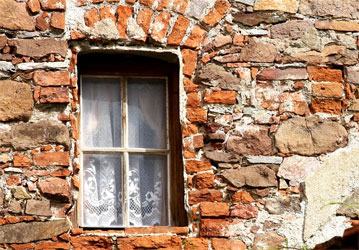Recurring Dream

Sometimes I imagine
knocking on the door of the old house
at 208 59th Street, introducing myself
to the stranger, who opens it a crack.
I explain that my Italian grandfather,
a carpenter from Calabria, built this house,
stone on stone.
I speak English, not knowing
Korean, his language, which has replaced
Italian and Puerto Rican Spanish in the old
neighborhood overlooking the Hudson.
I am the stranger now, longing only
to step into the cool dark hallway again,
climb the stairs to the kitchen—still tiled
in white, with a green linoleum floor?
I wonder if a pulley outside the kitchen window
still manipulates the clothesline
where Nonno’s white shirts used to flap
above the fig trees growing miraculously
in the cement garden.
I recall the Singer sewing machine
on which Nonna’s black lace-up shoes
pedaled rick-rack to edge the muslin pillowslips.
And though I talk in English, he would understand
how, years ago, Bergenline Avenue offered
not Asian delicacies but caged chickens
ready for plucking, and cipollini, little onions
that tasted like butter. I explain
how my sister and I chalked hopscotch
on the sidewalk, inscribing our childhood
in pink and blue squares at the pumiced doorstep,
how the smell of Nonna’s mothballed linens
and the sweet smoke of Nonno’s pipe
will cling to these walls forever.
knocking on the door of the old house
at 208 59th Street, introducing myself
to the stranger, who opens it a crack.
I explain that my Italian grandfather,
a carpenter from Calabria, built this house,
stone on stone.
I speak English, not knowing
Korean, his language, which has replaced
Italian and Puerto Rican Spanish in the old
neighborhood overlooking the Hudson.
I am the stranger now, longing only
to step into the cool dark hallway again,
climb the stairs to the kitchen—still tiled
in white, with a green linoleum floor?
I wonder if a pulley outside the kitchen window
still manipulates the clothesline
where Nonno’s white shirts used to flap
above the fig trees growing miraculously
in the cement garden.
I recall the Singer sewing machine
on which Nonna’s black lace-up shoes
pedaled rick-rack to edge the muslin pillowslips.
And though I talk in English, he would understand
how, years ago, Bergenline Avenue offered
not Asian delicacies but caged chickens
ready for plucking, and cipollini, little onions
that tasted like butter. I explain
how my sister and I chalked hopscotch
on the sidewalk, inscribing our childhood
in pink and blue squares at the pumiced doorstep,
how the smell of Nonna’s mothballed linens
and the sweet smoke of Nonno’s pipe
will cling to these walls forever.

The Piker Press moderates all comments.
Click here for the commenting policy.